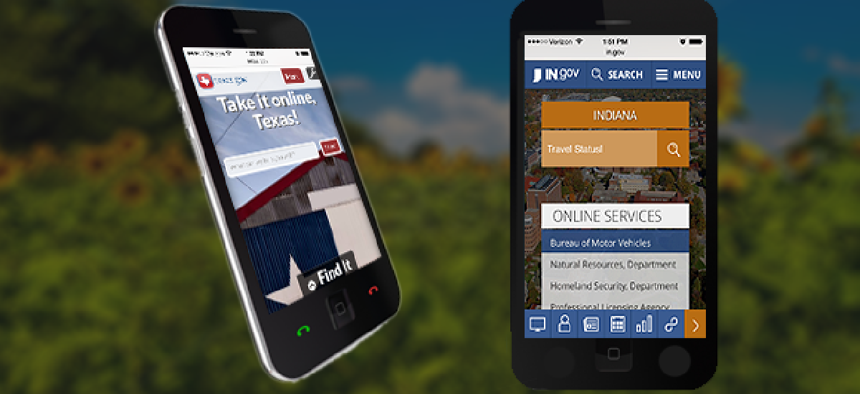States go for mobile makeovers


Connecting state and local government leaders
Five states have revamped websites to offer better search, mobile-friendliness and improved citizen services, while a sixth is out with an Apple Watch app.
The shift towards responsive design for multiple-device compatibility, increased search capabilities and mobile usage has driven a number of states to redesign and refresh their websites to offer more services online.
Utah, Texas, Maine, Alabama and Indiana have recently undergone a website makeover. And in Arkansas, the state government and NIC, an eGovernment services provider, presented the first official government application for the Apple Watch this week called Gov2Go. According to NIC, Mississippi, Maryland and Texas are next.
The new app offers a personalized calendar where citizens can keep track of government deadlines and send reminders for property tax due dates, registration renewals and more.
“These new generation sites, they’re smart, efficient, extremely well thought out and implemented, and usually a year or more in the making,” said Rich Olsen, one of NIC's vice presidents of portal operations. NIC also supported the Utah, Alabama, Texas and Maine website redesigns.
According to Olsen, the website refreshes were driven by years of user analytics data and citizen expectations. Each state’s site is uniquely suited to fit its audience based on interpretations of what their users want and need from their digital government.
For example, Texas’ site uses southern-style lingo (“These are a big hit with y’all!”) and statewide photos in order to give citizens that “home-like” feel, and Alabama’s “Connect with Alabama” tab shows up-to-date social media posts from government-affiliated accounts. The most important trend, however, was search optimization.
“Search is absolutely the keystone of almost every new site now,” said Olsen, “well over 80 percent of all the action on state websites is search.” Mission-driven users are looking for quick services, productivity and simplicity when visiting their government’s homepage.
Utah’s new Master Data Index allows citizens to plug in what they’re looking for, even a single term, and receive a number of location-based results from blogs, news, events, services, relative departments or agencies affiliated with the state and social media accounts and posts.
Geo-tagging for personalized and localized search results and efficient “microsites” and categories are making services easily accessible and findable on these sites.
Other trends include long-scrolling and flattened sites to support fewer clicks and more fluidity. The single-page feature of responsive design allows sites to fit on all screen sizes. In fact, According to State Scoop, Texas was the first state site to have all content solely on one page.
“We have over 600 combinations of devices and operating systems, so there is a lot of thought to building a single book that will look great on all of these different combinations of devices and operating systems,” Olsen said.
Utah set a new standard also, by starting with a bare essentials mobile platform and moving upwards to a desktop screen, according to Chris Neff, NIC’s vice president of marketing.
On a smaller scale, city websites are achieving similar goals with website redesign. Palm Bay, Fla., reported a 74 percent increase in mobile site usage just one year after its launch, according to a report by Vision Internet, a Santa Monica, Calif., website developer.
While websites often focus on uniqueness of the city and specific local needs, most are moving to responsive design and place a strong emphasis on mobile friendliness. Plus, feedback from citizen and staff surveys, web analytics of frequented sites and heat maps are being used to inform the website designs.
“The core purpose of any local government online presence is to fundamentally serve their communities, so finding out what the top tasks the users are trying to complete on the site and then offering a feature that’s allowing them to do that effectively on the site is really key,” said Ashley Fruechting, Vision Internet’s senior director of strategic planning.
Other states are even adding features like maps, alerts, advisories, notification services, personalized portals and blogs with more local content and news. For example, Indiana incorporated a My.IN.gov portal, which allows users to customize the information they receive. A Travel Advisory feature offers travel statuses in each county and GovDelivery, the state’s enterprise email notification and text message system, has prioritized local content for subscribed users .
Neff said there is a high demand from users to enhance notification systems and have information pushed through mobile transactions, such as receiving a SMS reminder to renew a driver’s license. Users, however, will always want more.
According to a study by the University of Utah on citizen satisfaction with the state’s digital government services, 87 percent of Utah.gov users found the services valuable, but 75 percent expect the state to continue improving the site and expanding access services.
As devices evolve and wearable technology expands, governments will continue to upgrade services, transparency and efficiency with their sites and mobile options. “State government is really now seeing the value in innovation and seeing the value in what these online services and web presence can do for them,” Olsen said.
And mobile-focused upgrades aren't limited to the state level. The National Park Service recently made all its park websites mobile-friendly, and WhiteHouse.Gov moved to responsive design in April.




